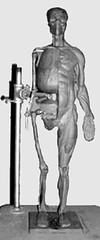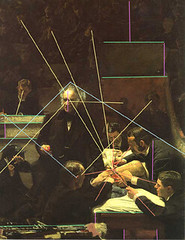Please Help If You Can !
November 17, 2006
Philadelphia, PA (November 17, 2006) -- The Philadelphia Museum of Art, the Pennsylvania Academy of the Fine Arts, public and private institutions, city officials, and civic leaders are joining forces in the effort to raise $68 million to keep Thomas Eakins’ 1875 masterpiece, The Gross Clinic, in Philadelphia. Partners in the drive to keep the spectacular painting in the city where it was painted have established The Fund for Eakins’ Masterpiece and, recognizing the difficulty of the challenge, are reaching out to the community for support. The action comes in response to an announcement by the painting’s owner, Thomas Jefferson University, that local art museums and governmental institutions must match the price by December 26, 2006, or the painting will be sold to the Crystal Bridges Museum of American Art in Bentonville, Arkansas, founded by Alice L. Walton, and scheduled to open in 2009, and the National Gallery of Art in Washington, D.C.
Thomas Eakins (1844-1916) was both a student and extraordinarily influential teacher at the Pennsylvania Academy. The Academy also maintains the Bregler Collection, which contains a vast number of Eakins' drawings, perspective studies, memorabilia, photographs, and letters. The Philadelphia Museum of Art houses the largest collection of his work, which was largely the gift of Eakins’ widow and a close friend of the artist’s family in 1929 and 1930. The artist’s achievement is inextricably bound to Philadelphia life, past and present, and The Gross Clinic is widely considered to be one of the great masterpieces of American painting.
Philadelphia Mayor John F. Street endorsed the effort to keep the painting in Philadelphia. He said, “I am encouraged by the strong voices of support within our community for keeping this magnificent painting in Philadelphia. Our city has an extraordinary fabric of arts and culture which makes us a magnet for visitors from all across the nation and around the world, and provides a great quality of life for all of our citizens. Retaining The Gross Clinic will underscore that reality and ensure a place in the heart of our city for this treasured painting.”
“The Gross Clinic is a tremendous work of immeasurable value to Philadelphia,” said Donald R. Caldwell, Chair of the Board of Trustees of the Pennsylvania Academy of the Fine Arts. “Philadelphia is where so much scholarship on his outstanding place in American art has been developed, and our city is the most appropriate venue for what is widely considered Eakins’ most important painting. It is imperative that The Gross Clinic remains here, and we are working together to find a way to make that happen.”
Anne d’Harnoncourt, Director and CEO of the Philadelphia Museum of Art, stated: “The public outpouring of concern has been extraordinary, both locally and from around the country, and we all agreed that Philadelphians must establish a fund to which the public can contribute.
“By working together, our city may be able to preserve Eakins’ greatest work in Philadelphia, where his enduring presence and influence are so profoundly felt. It is a difficult challenge but it’s not impossible and we should be optimistic.”
How to Give
The public can help by giving to the Fund for Eakins’ Masterpiece, established to raise the money to match the sale price of $68 million. Make a tax deductible contribution online at www.philamuseum.org/keepeakins, or mail a check made payable to Fund for Eakins’ Masterpiece and send it to Fund for Eakins’ Masterpiece, c/o Philadelphia Museum of Art, P.O. Box 7646, Philadelphia, PA 19130-7646. The Fund for Eakins’ Masterpiece HOTLINE is reachable by calling 215-684-7762.
About The Gross Clinic
Painted in 1875, The Gross Clinic is widely considered Eakins’ finest work. The 8’ by 6’ painting, which stands as a testament to the strides Philadelphia made in the medical and educational fields, depicts famed Philadelphia Dr. Samuel D. Gross performing bone surgery on a young man, while a woman often thought to be the patient’s mother cringes in the middle ground. Depicted in Jefferson’s surgical ampitheater, Gross is dramatically caught in a shaft of light from the skylight, and turns majestically away from the patient to address his students as his assistants continue their work. From this perspective, the viewer occupies a seat alongside Gross’ students. At the right, Eakins depicts himself in the audience, attentively recording the scene.
The Gross Clinic, which Eakins completed when he was 31, was submitted for the 1876 Centennial Exhibition but was rejected from the Fine Art Gallery in Philadelphia’s Memorial Hall because of its shocking content.
Probably through the machinations of Dr. Gross and his colleagues, however, it was placed on view on the Centennial grounds at the United States Army Post Hospital, in a ward filled with hospital bedding and furniture. Commentators wondered at the placement: “It was one of the most powerful and life-like pictures to be seen at the Exhibition, and should have had a place at the Art Gallery, where it would have been seen but for an incomprehensible decision by the Selecting Committee.”
The critic William Clark—who had earlier written, “This portrait of Dr. Gross is a great work—we know of nothing greater that has ever been executed in America,” returned to his defense of the picture: “There is nothing so fine in the American section of the Art Department of the Exhibition and it is a great pity that the squeamishness of the Selection Committee compelled the artist to find a place in the United States Hospital Building. It is rumored that the blood on Dr. Gross’s fingers made some of the committee members sick, but, judging from the quality of the works exhibited by them we fear that it was not the blood alone that made them sick. Artists have before now been known to sicken at the sight of pictures by younger men which they in their souls were compelled to acknowledge were beyond their emulation.” (Marc Simpson, in The 1870s, essay in Thomas Eakins (Philadelphia Museum of Art 2001) ed. Darrel Sewell)
An art critic for the New York Tribune called it “one of the most powerful, horrible yet fascinating pictures that has been painted anywhere in this century …” In 2002, when it was exhibited in the Philadelphia Museum of Art-organized Thomas Eakins: American Realist retrospective exhibition at New York City’s Metropolitan Museum of Art, New York Times art critic Michael Kimmelman called it “hands down, the finest 19th century American painting …”
The painting was purchased for $200 by Jefferson alumni and given to the institution in 1878. It has remained on view at Jefferson, where Eakins himself studied anatomy, since its donation, except for periodic loans to exhibitions across the country.
About the Pennsylvania Academy of the Fine Arts
Founded in 1805, the Pennsylvania Academy of the Fine Arts is America's oldest continually operating school of fine arts and museum. A recipient of the 2005 National Medal of Arts presented by the President of the United
States of America, the Academy is a recognized leader in fine arts education. The institution's world-class collection of American art continues to grow and includes major works by the Academy's faculty and alumni, both current and historic.
About the Philadelphia Museum of Art
The Philadelphia Museum of Art is among the largest art museums in the United States, showcasing more than 2,000 years of exceptional human creativity in masterpieces of painting, sculpture, works on paper, decorative arts and architectural settings from Europe, Asia and the Americas. The striking neoclassical building stands on a nine-acre site above the Benjamin Franklin Parkway and houses more than 200 galleries. The Museum offers a wide variety of enriching activities, including programs for children and families, lectures, concerts and films.


